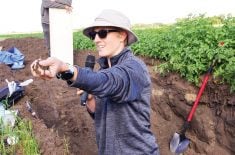Farmers can now plug nearby weather conditions into a calculator to determine the local risk for insects and crop diseases.
WeatherFarm should come in handy for farmers trying to remove the guesswork when deciding whether to spray, Keystone Agricultural Producers president Ian Wishart said about the free, internet-based program.
“It’s a pretty neat tool.”
The Canadian Wheat Board is providing WeatherFarm as an expansion to its WeatherBug program, which uses more than 700 local mini weather stations and information from Environment Canada and other sources to provide local and regional weather information.
Read Also

Soybean market still figuring out implications of China-U.S. pact
Soybean futures had a muted reaction to the U.S. trade deal with China as the market tries to figure out the nuances of the deal.
Producers can now use this local information to assess the risk for fusarium headblight and wheat midge on their farms.
The board plans to add risk assessment tools over time so farmers can analyze the risk of other production concerns.
Wind gauges on the weather stations will help farmers decide when and how to spray on their farm, and historical weather data will allow them to see how past weather conditions affected their crops.
“This is the future of weather information,” said CWB chief executive officer Ian White at a news conference announcing the system.
WeatherFarm will also carry 10-minute delayed commodity price quotes and other information that farmers want, which White said will turn the WeatherFarm site into a one-stop shop for basic agricultural information.
Farmers who want to install a station on their farm or add another one will pay approximately $1,750.
Wishart said he and other Portage la Prairie potato growers have used a similar system, with mixed results.
They had to rely on one weather station every 10 kilometres, which wasn’t enough to provide reliable data for on-farm weather conditions.
The WeatherBug system has more sites, so that problem should be minimized. However, Wishart said producers will need to judge how well the system reflects the real conditions on their farms.
The wheat board’s WeatherBug system is part of a much-larger system that a U.S. company offers to farmers and other industries in the United States.
The board has spent $1 million setting up WeatherBug and WeatherFarm for prairie farmers, but it hopes the operating costs can be covered mainly by commercial sponsors, including grain companies and other agricultural businesses.
Many companies have embraced WeatherBug, with some such as Richardson International and Bayer CropScience helping launch it two years ago.
Media partners include The Western Producer and Farm Business Communications, with data accessible through their websites.
White said customized weather data will benefit individual farmers, but it will also provide the board with production intelligence.















